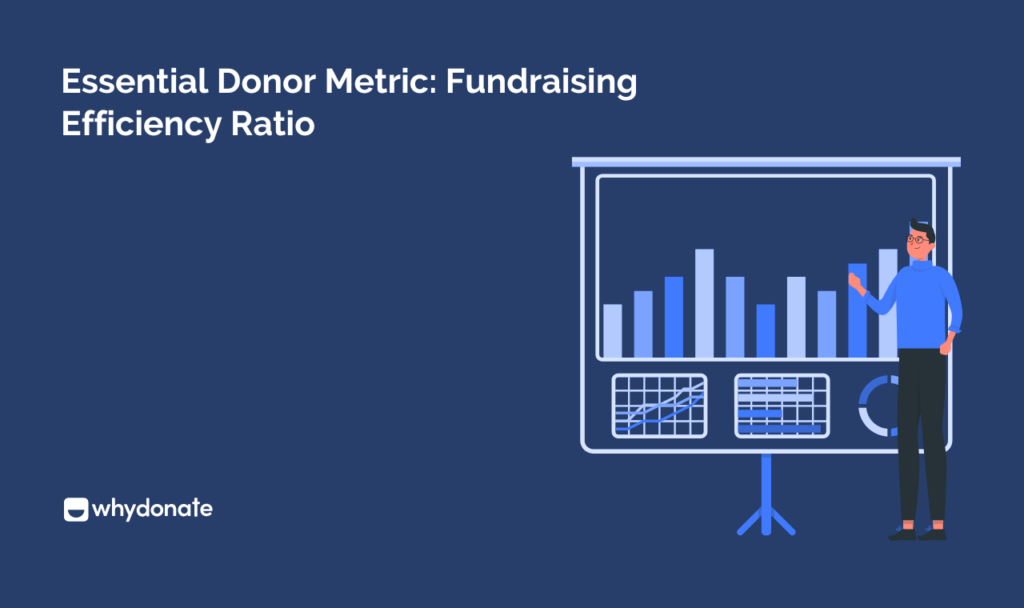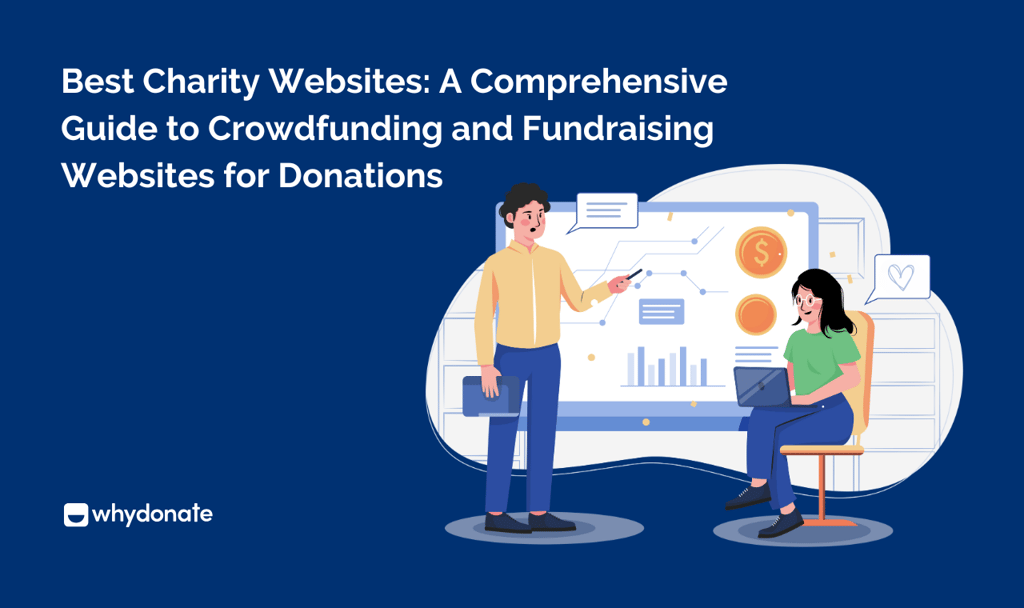Table of Contents
What Is Efficiency Ratio (%)?
The fundraising efficiency ratio for nonprofits is a measure of financial value used to assess the effectiveness of fundraising initiatives by a business by comparing the revenue generated by fundraising versus the expenses involved in carrying out the fundraising activities. As a percentage, it measures the effectiveness with which a company can turn fundraising expenses into revenues.
Higher numbers indicate that the fundraising strategy is more efficient. This measure can provide valuable insight into a company’s capability to boost the amount of funds raised relative to the sum spent and allows stakeholders to assess the financial sustainability as well as its efficiency in achieving its fundraising goals.
- Are You Struggling With Financial Issues? Start A Fundraising Campaign For FREE At WhyDonate!
How To Calculate Fundraising Efficiency Ratio?
Calculating the proportion of effectiveness in fundraising involves measuring the connection between the total amount of revenue from raising funds and expenditures incurred during these activities. The steps to consider:
1. Indicate Total Revenue
Find out the total amount generated from fundraising events during a specific time frame, generally a financial year. It includes donations, gifts, corporate sponsorships, and other income directly connected to fundraising initiatives.
2. Determine Total Fundraising Expenses
Estimate the total cost of fundraising-related events for the same period. These include everything directly connected to fundraising, such as the salary and other benefits for the fundraising team, promotional and marketing tools, event-related expenses, fundraising software and expenses, and the additional costs necessary to obtain donations or support.
3. Calculate Using The Fundraising Efficiency Ratio Formula
Once you’ve accumulated the entire amount of income and all costs related to fundraising, you could utilize the fundraising efficiency ratio formula below to determine your fundraising effectiveness percentage:
Efficiency Ratio (%) = Total Fundraising Expenses/Total Revenue ×100%
4. Interpret The Result
The percentage of results that show the efficiency of the organization’s fundraising initiatives. A higher percentage indicates that it is more successful at converting the funds generated by fundraising into revenue, while a lower amount indicates lower efficacy.
5. Pay Attention To The Contextual Factors
Although the percentage of fundraising efficiency can be a valuable indicator, it’s essential to consider the more significant conditions of the business in addition to its fundraising goals and standards in the field. Comparison of the ratio with benchmarks within the field of nonprofits or against past performance can provide more information about the context of how to assess.
When taking these steps and calculating the proportion of the fundraising efficiency ratio, you can examine the efficiency of their plans for fundraising and pinpoint areas that need improvement to enhance the effectiveness of their fundraising overall.

Key Performance Indicators (KPI) For The Fundraising Efficiency Ratio For NonProfits
Key performance indicators, also known as donor metrics, will allow companies to evaluate and monitor the efficacy of their fundraising methods. These are some of the most important KPIs you should be thinking about other than the efficiency ratio:
1. Donor Acquisition Cost
Donor Acquisition Cost KPI is the measure of how much it costs to acquire donors. This is achieved by subdividing the total expenses associated with acquisition (such as marketing and outreach costs) by the number of new donors acquired over the specified period of time.
2. Total Revenue
Tracking the revenue amount from fundraising initiatives allows businesses to assess their effectiveness at fundraising over time and discern patterns within the pattern of contributions.
3. Total Costs of Fundraising
The monitoring of the expenses that are incurred in fundraising provides an understanding of expenses associated with generating income. This aids in planning budgets and the allocation of funds.
4. Price Per Dollar
The price of contributions is calculated by using the technique of subdividing the total cost of fundraising by the total revenue. This is the price to raise a dollar in donations. The lower cost per dollar can be an indicator of better effectiveness when it comes to raising funds.
5. Return On Investment
ROI is a measure of the amount earned through fundraisers, along with the invested expenses that occurred during these fundraising events. It can aid in assessing the effectiveness and efficacy of fundraising.
6. The Donor’s Lifetime Valuation
Donor lifetime valuation estimates the sum of donations’ contributions during their entire time of service to the business. It assists in devising the most effective methods of cultivation and distribution of the funds effectively.
7. Donor Retention Rate
This is the proportion of donors that continue to give back to the charity in the long run. A high donor retention rate indicates effective stewardship and relationship-building efforts, which can contribute to long-term fundraising success.
8. Cost-to-Income Ratio
Similar to the efficiency ratio of fundraising, this KPI is a measure of the total expense of fundraising minus the total amount of profits (including earnings from different sources, in addition to the funds raised). It offers a more complete picture of the viability of the business’s financials.
9. Fundraising Revenue Growth Rate
This measure is the rate of revenue growth from fundraising throughout the time. It allows companies to gauge their capability to expand their fundraising efforts and attract more patrons.

9 Primary Reasons For A Poor Fundraising Efficiency Ratio
There are many factors that could be the reason for an insufficient performance ratio.
- High Costs For Fundraising: Excessive spending on fundraising activities, including extravagant celebrations, costly marketing strategies, or poorly executed fundraising methods, will raise costs, however, without any increase in the amount of revenue.
- Ineffective Strategies For Fundraising: Fundraising campaigns that fail to engage donors or effectively communicate the mission and purpose of your organization may result in less donor response as well as fewer donations. This can decrease the efficiency of your campaigns to raise funds.
- Insufficient Engagement From Donors: The inability to connect with donors and build good donor relationships could result in lower donor retention, as well as a decreased willingness to give, which could impact fundraising effectiveness negatively. This can also lead to donor fatigue.
- Inefficient Resource Allocation: A poorly planned resource allocation, including budgets, staff time, and technology, could hinder the efficiency and effectiveness of fundraising, which could cause poor results and reduced efficiency.
- An Absence Of Diversification: Relying too much on one channel to raise funds and sources of donations puts anorganizationn at risk and hampers its ability to adapt to changes in economic conditions or the preferences of donors. This can lead to reduced revenue or less effectiveness.
- The Absence Of Planning And Evaluation: The failure to develop the plan in a comprehensive manner, establish realistic goals, and regularly evaluate fundraising results could limit the ability of a company to identify obstacles, address challenges, and formulate strategies to increase the effectiveness of fundraising.
- Economic Influences: The economic climate, such as receding and declining markets, can influence donors’ capacity or desire to contribute and result in a drop in the amount of money raised and a decrease in efficiency.
- Internal Issues: Organisational aspects such as leadership changes, the turnover of staff, and the lack of coherence between the objectives of fundraising and the goals of the company can cause difficulties in successful fundraising and lead to poor performance.
- Compliance Issues: The failure to comply with the rules or guidelines of ethical conduct when it comes to fundraising may damage the reputation of an organization, undermine the trust of donors, and reduce the effectiveness and efficiency of the fundraising process.
How To Improve Your Fundraising Efficiency Ratio?
For you to boost your success in fundraising, you should consider using these methods:
- Streamline Fundraising Processes: Identify and eliminate the inefficiencies of fundraising in order to lower costs and boost the efficiency of your funds. Automate repetitive activities, streamline communication channels and utilize technologies to increase the efficiency of your fundraising.
- Focus On High-Impact Activities: Sort out fundraising strategies and projects that have demonstrated success at generating large returns. Dedicate resources to projects that have the most chance of being successful, as well as end activities that generate low returns on the investment.
- Increase Donor Engagement: Create positive connections with donors through individual communications, donor stewardship, and donor-centric strategies. Share thank-you letters to show gratitude for the goals of theorganizationn and provide ways to engage them and increase their effect.
- Diversify Fundraising Channels: Expand your fundraising efforts across many avenues, including online fundraising, such as e-mail fundraising, sponsorships, fundraising ideas, and major donations. Diversification can lower risk and allow you to increase the number of donors you can reach.
- Focus On Donor Retention & Acquisition: Be sure that you have resources allocated to strategies for recruiting donors in order to tap into the latest market and expand your database of supporters. Also, consider strategies to retain donors to strengthen relationships with those who already are in your donor database and encourage frequent giving in the future.
- Increase Fundraising Campaigns: Always examine and evaluate your fundraising activities to identify areas for improvement and ways to optimize. Examine different tactics, strategies, and messaging to find the most efficient method to get your message across to the intended target audience and achieve the most effective results.
- Review And Analyse Outcomes: Track regularly significant measures of success in relation to fundraising efficiency, the revenue that is generated, donor engagement, and the efficiency of your fundraising campaign. Make use of analytics and data to assess the effectiveness of your fundraising efforts and help guide the strategic decisions you make.

Ending Note!
Achieving greater fundraising effectiveness is an active and strategic plan for managing your fundraising. Through streamlining methods, enhancing donor engagement, employing a range of methods to raise money, monitoring results as well as improving transparency in the fundraising process, businesses are able to improve their effectiveness in fundraising and achieve greater effectiveness in achieving their goals.
If money problems are making you short of your aspirations, consider starting an online fundraising campaign for FREE and harness WhyDonate’s extensive donor network.
FAQs (Frequently Asked Questions)
What is the fundraising efficiency metric?
The fundraising efficiency measure measures the efficacy of the fundraising effort by comparing the money raised through fundraising to the cost paid for these operations.
What is a good fundraising efficiency ratio?
A high efficiency of fundraising is contingent in part on the amount of the business, its goals, and its fundraising plan. An increase in the percentage indicates higher efficacy. However, the criteria for a good ratio may differ according to benchmarks in the industry as well as the organization’s goals.
How do you measure fundraising success?
Success in fundraising is measured by varying indicators, like the amount of revenue generated, the retention rate, the cost of acquisition to donors, ROI, and the general impact it has on the goals of the company. The analysis of these measures can provide insight into the effectiveness of fundraising initiatives.

















